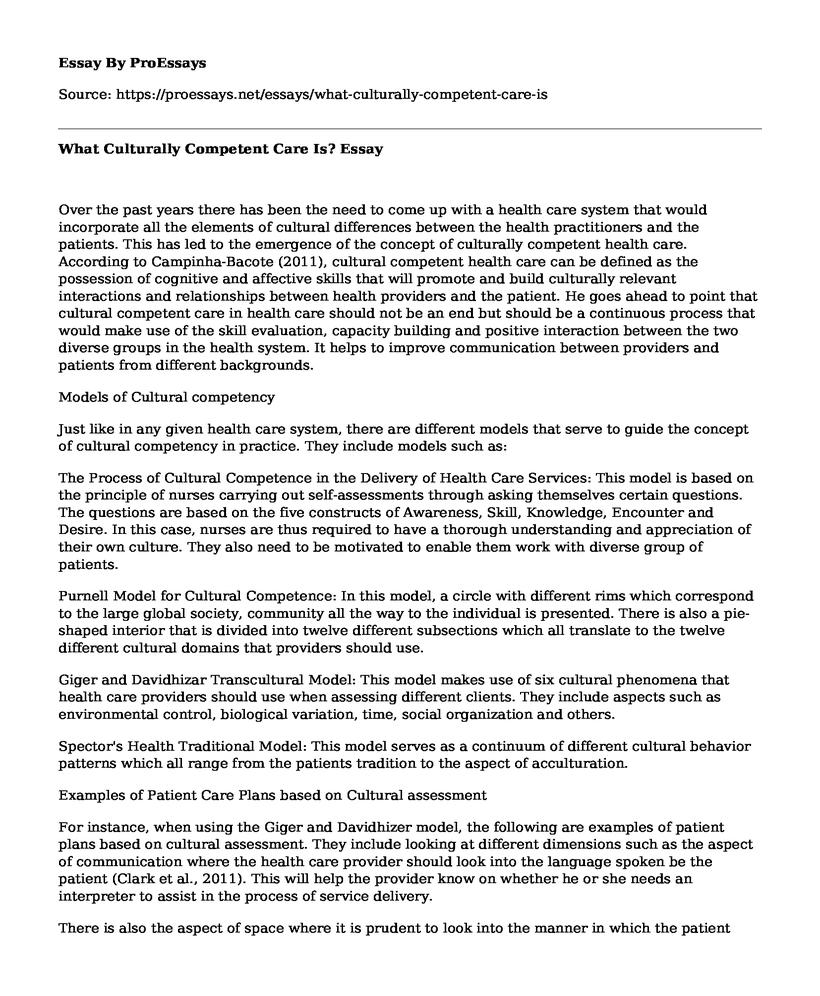Over the past years there has been the need to come up with a health care system that would incorporate all the elements of cultural differences between the health practitioners and the patients. This has led to the emergence of the concept of culturally competent health care. According to Campinha-Bacote (2011), cultural competent health care can be defined as the possession of cognitive and affective skills that will promote and build culturally relevant interactions and relationships between health providers and the patient. He goes ahead to point that cultural competent care in health care should not be an end but should be a continuous process that would make use of the skill evaluation, capacity building and positive interaction between the two diverse groups in the health system. It helps to improve communication between providers and patients from different backgrounds.
Models of Cultural competency
Just like in any given health care system, there are different models that serve to guide the concept of cultural competency in practice. They include models such as:
The Process of Cultural Competence in the Delivery of Health Care Services: This model is based on the principle of nurses carrying out self-assessments through asking themselves certain questions. The questions are based on the five constructs of Awareness, Skill, Knowledge, Encounter and Desire. In this case, nurses are thus required to have a thorough understanding and appreciation of their own culture. They also need to be motivated to enable them work with diverse group of patients.
Purnell Model for Cultural Competence: In this model, a circle with different rims which correspond to the large global society, community all the way to the individual is presented. There is also a pie-shaped interior that is divided into twelve different subsections which all translate to the twelve different cultural domains that providers should use.
Giger and Davidhizar Transcultural Model: This model makes use of six cultural phenomena that health care providers should use when assessing different clients. They include aspects such as environmental control, biological variation, time, social organization and others.
Spector's Health Traditional Model: This model serves as a continuum of different cultural behavior patterns which all range from the patients tradition to the aspect of acculturation.
Examples of Patient Care Plans based on Cultural assessment
For instance, when using the Giger and Davidhizer model, the following are examples of patient plans based on cultural assessment. They include looking at different dimensions such as the aspect of communication where the health care provider should look into the language spoken be the patient (Clark et al., 2011). This will help the provider know on whether he or she needs an interpreter to assist in the process of service delivery.
There is also the aspect of space where it is prudent to look into the manner in which the patient shows or demonstrate comfort when in proximal distance to others (Clark et al., 2011). This gives the provider the necessary clues as to whether the patient is introverted or extroverted and this is a good way to start the health care session.
Another Patient Care Plan based on cultural assessment should be one that looks into the biological variation of the patients. This is an important plan as it helps to know the medical history of the patient. This plan is an important point of reference before embarking on any diagnostic care.
The aspect of Time and Social Orientation are other Patient plans that can be based on the concept of cultural assessment of the patients. This is good for knowing the medical and personal orientation of the patient towards the future, past and present. It also helps one to understand the different beliefs held by the patient that might promote or prevent the diagnosis.
What Healthcare Providers can do to develop cultural competency?
As part of developing the cultural competence among the health care providers, one of the main factors that the professional body of nurses should consider is education. They should prepare nurses by providing them with the necessary skills and training that is requisite in the concept of cultural competence (Like, 2011). This should serve as the first process in the capacity building. There is also the need for patient education by the health provider. This will make them aware of the importance of the concept of cultural competent care in their health program. Health care providers should also learn to appreciate and value different cultures starting from the languages and other cultural aspects that will help them hone their skills in the aspect of service delivery to different patients.Reference
Campinha-Bacote, J. (2011). Delivering patient-centered care in the midst of a cultural conflict: The role of cultural competence. The Online Journal of Issues in Nursing, 16(2).Clark, L., Calvillo, E., Dela Cruz, F., Fongwa, M., Kools, S., Lowe, J., & Mastel-Smith, B. (2011). Cultural competencies for graduate nursing education. Journal of Professional Nursing, 27(3), 133-139.
Douglas, M. K., Pierce, J. U., Rosenkoetter, M., Pacquiao, D., Callister, L. C., Hattar-Pollara, M., ... & Purnell, L. (2011). Standards of practice for culturally competent nursing care: 2011 update. Journal of Transcultural Nursing, 22(4), 317.Like, R. C. (2011). Educating clinicians about cultural competence and disparities in health and health care. Journal of Continuing Education in the Health Professions, 31(3), 196-206.
Cite this page
What Culturally Competent Care Is?. (2021, Mar 09). Retrieved from https://proessays.net/essays/what-culturally-competent-care-is
If you are the original author of this essay and no longer wish to have it published on the ProEssays website, please click below to request its removal:







